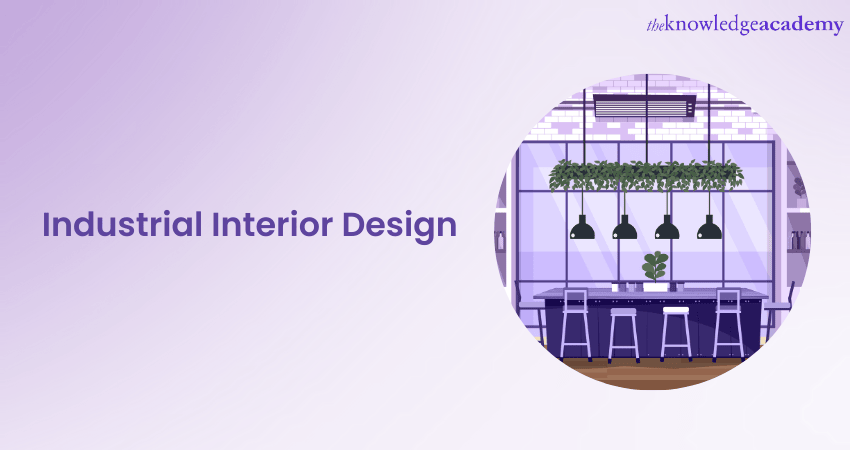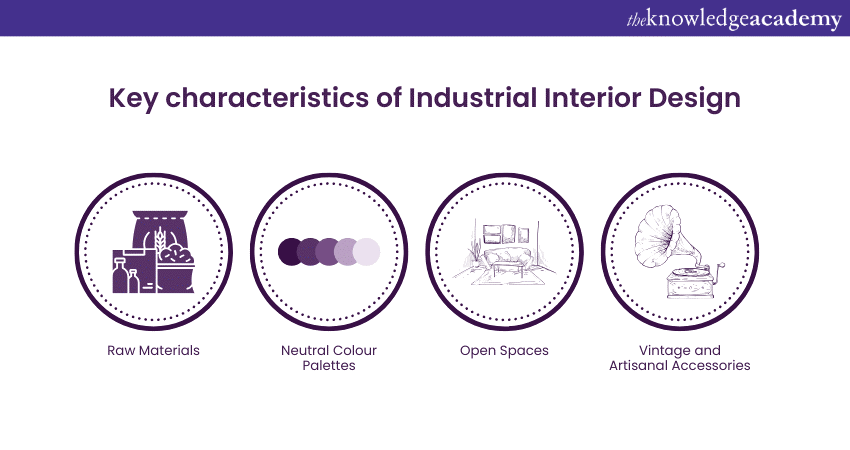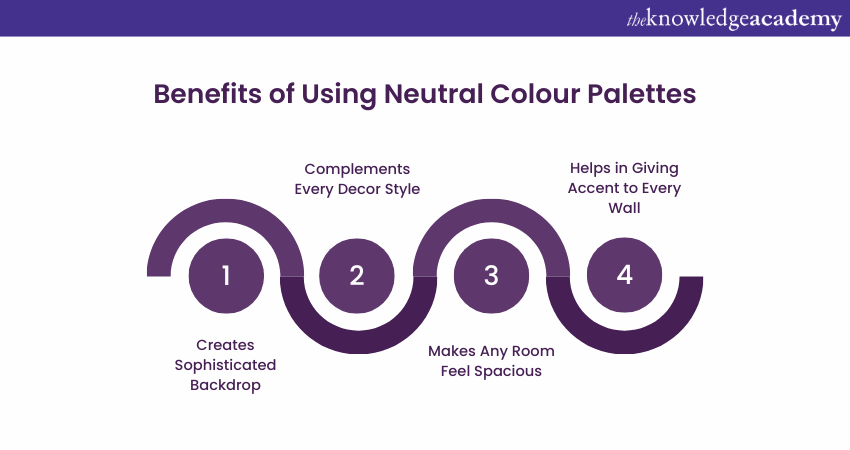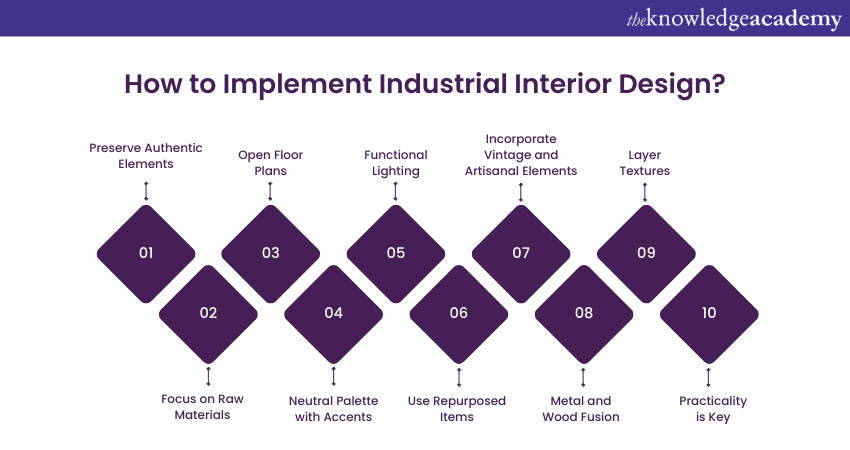We may not have the course you’re looking for. If you enquire or give us a call on 01344203999 and speak to our training experts, we may still be able to help with your training requirements.
We ensure quality, budget-alignment, and timely delivery by our expert instructors.

Industrial Interior Design is often associated with loft apartments, repurposed warehouses, and modern commercial spaces; this style embraces exposed architecture, neutral tones, and a blend of metal and wood elements. This style transforms the seemingly mundane elements such as exposed bricks, unfinished metals, and bare beams into sophisticated design elements. In this blog, you’ll learn about Industrial Interior Design, its key elements, applications and its future. Read ahead to know more!
Table of Contents
1) What is Industrial Interior Design?
2) A Brief History of Industrial Interior Design
3) Key Characteristics of Industrial Interior Design
3) Implementing Industrial Interior Design: Tips and Best Practices
4) What are the Four Types of Industrial Design?
5) Is Industrial Decor Still in Style?
6) Conclusion
What is Industrial Interior Design
Industrial Interior Design is a unique blend of the past and present, transforming old industrial spaces into modern, functional areas. For instance, a former brewery can be converted into a stunning open office with innovative design solutions. This trend of repurposing industrial areas into living spaces rather than new factories helps reduce our material footprint.
The "warehouse look" has become a popular request among designers and architects. Industrial Interior Design emphasises exposing what was once hidden, showcasing building materials to create a raw, unfinished look. It's now common to visit restaurants or cafes and see exposed pipes, ductwork, large windows, and other functional elements seamlessly integrated with modern furniture and lighting, creating a distinctive and stylish atmosphere.

A Brief History of Industrial Interior Design
Love vibrant and eclectic spaces? Get inspired with our guide on Maximalist Interior Design!
Industrial Interior Design, often seen as modern, has roots in the Industrial Revolution.
1) First Industrial Revolution (1760s): This era introduced mass production in Europe and the U.S., leading to factories with large windows, open layouts, and exposed brick walls for safety.
2) Second Industrial Revolution (1870s): Larger factories emerged, using concrete and steel. The Edison light bulb, a key feature of industrial lighting, was invented in 1879.
3) 2000s Housing Shortages: Urban areas converted old factories into loft apartments, highlighting exposed materials and large windows as desirable features.
4) Rise of Minimalism and Hygge: The minimalist movement embraced industrial design for its rustic, clean lines. This style also fits well with Scandinavian hygge, blending neutral palettes and raw materials.
Key Characteristics of Industrial Interior Design
To understand the Industrial Interior Design style better, let’s look at some of the key characteristics of this Interior Design:

Raw Materials and Exposed Architecture
Raw materials in Industrial Design refer to unrefined or minimally processed materials that maintain their natural or original appearance. Exposed architecture means that the design elements are left uncovered or displayed intentionally, showcasing the structural components of a space.
Here are some more points to help you get a better understanding:
1) Popular Raw Materials:
a) Concrete: Often seen on floors, walls, and countertops. It provides a durable surface that can age beautifully with time.
b) Steel and Iron: Commonly used in beams, shelves, and furniture fixtures. They introduce a robust, industrial feel.
c) Bricks: Exposed brick walls are a staple of this design philosophy. They give warmth, and texture and add an old-world charm.
d) Weathered Wood: Used in flooring, furniture, or ceilings. It offers an earthy touch and contrasts well with more metallic elements.
2) Significance of Exposed Architecture:
a) Ductwork: Leaving ducts and vents visible adds an element of authenticity, reminiscent of old factories and lofts.
b) Beams and Piping: Exposed wooden or steel beams and visible piping can act as strong visual elements, adding layers and depth to a space.
c) Electrical Conduits: Instead of hiding them, electrical pathways can be displayed as design elements, adding to the industrial vibe.
While deeply rooted in old industrial spaces, raw materials and exposed architecture can be adapted to fit even the most contemporary settings, showing their versatility and wide appeal.
Neutral Colour Palettes
A neutral colour palette involves using shades that are subdued and unobtrusive, often functioning as background colours. This palette includes hues like beige, ivory, taupe, black, grey, and shades of white.
These points will help explain this further:

1) Their understated nature can create a sophisticated backdrop to any interior space, giving a room a serene and polished look.
2) They can complement almost any decor style, from Minimalist and Contemporary to Rustic and Traditional.
3) Neutral colours have the ability to make a room feel more spacious. Lighter shades, such as off-white or light grey, can amplify natural light, creating an airy and open atmosphere.
4) They provide a stable foundation for introducing other colours. A neutral background allows for vibrant accents and patterns to pop without overwhelming the space.
5) Employing a neutral palette can bring a harmonious feel to homes, especially open-plan spaces. It creates a fluid transition between rooms, promoting a sense of cohesion and unity.
6) With a subdued colour scheme, the emphasis often shifts to textures and structural elements. The play of light on different surfaces, the grain of a wooden table, or the weave of a fabric becomes more noticeable, much like how Data Fabric Architecture highlights the intricate connections within a data ecosystem.
7) They are also often associated with calmness, relaxation, and tranquillity. Spaces designed with a neutral palette can offer a quiet retreat from the hustle and bustle of daily life.
Open Spaces and Functional Elements
Open spaces refer to large, unobstructed areas within a structure, devoid of dividing walls or barriers. Functional elements, on the other hand, are design components that serve a specific purpose or utility, ensuring the space is both aesthetically pleasing and practical.
Here’s how they usually work:
1) Open plans are adaptable. They can be reconfigured with ease, allowing homeowners or designers to redefine the space according to changing needs or preferences.
2) There is an abundance of natural light. Without walls to block it, light can permeate the space freely, enhancing mood and energy levels and reducing dependency on artificial lighting.
3) In open spaces, functional pieces like kitchen islands, modular shelving, or statement lighting can become central design features. These pieces serve a dual purpose – functionality and aesthetic appeal.
4) These designs, by nature, eliminate the cramped feeling. They make interiors feel more expansive and breathable, providing a psychological sense of freedom.
5) Even in open spaces, there's a need for differentiation. Functional elements, like rugs or bookshelves, can demarcate areas without the need for walls. For instance, a rug can define a living area, while pendant lighting can highlight a dining zone.
6) Open spaces promote communal living and interaction. With fewer barriers, there’s an enhancement of social connectivity, making it easier for gatherings.
7) While the aesthetic aspect of design is vital, functionality ensures the space serves its inhabitants optimally. Open spaces adorned with functional elements strike this balance, proving that design can be both beautiful and pragmatic.
Unlock your design potential with our AutoCAD Training. Master the skills for precision and innovation in every project!
Vintage and Artisanal Accessories
Vintage items are typically several decades old, offering both aesthetic appeal and historical significance. Artisanal accessories, on the other hand, are handcrafted pieces made by skilled craftsmen, known for their unique designs, high-quality materials, and meticulous attention to detail. These distinctions are often highlighted in Interior Design Interview Questions to assess a designer's understanding of various design elements.
Here are some more points that will help you to understand these accessories better:
1) Both vintage and artisanal items are distinctive. Unlike mass-produced goods, they carry an individuality that can transform an ordinary space.
2) Opting for vintage items is a form of recycling. It promotes sustainable living by giving new life to old pieces, reducing the need for new production and thereby conserving resources.
3) Artisanal accessories showcase intricate work, from hand-painted ceramics to handwoven textiles, reflecting a commitment to craft rarely seen in industrial manufacturing.
4) Every vintage and artisanal piece has some significance about them. Whether it's a vintage mirror from a Parisian flea market or a handcrafted vase from a local potter, these accessories can serve as conversation starters, sparking interest and curiosity.
5) Vintage items, especially from notable periods or designers, can appreciate in value over time. Owning such pieces is not just an aesthetic choice but can also be a wise investment.
6) Artisanal accessories, with their handcrafted nature, offer tactile pleasure. The texture of a hand-knotted rug or the weight of a hand-forged metal bowl creates a multisensory experience for inhabitants.
7) While these items offer numerous benefits, they can be more expensive than mass-produced alternatives. Furthermore, vintage items may require careful maintenance to preserve their condition.
Transform your architectural visions into reality with our Revit Architecture Masterclass.
Implementing Industrial Interior Design: Tips and Best Practices
Here are some ways through which you can implement Industrial Interior Design:

1) Preserve Authentic Elements: If working with a space that has a history, try to maintain its original architectural elements. Exposed beams, brick walls, and original wood or concrete flooring can serve as a solid foundation for the industrial aesthetic.
2) Focus on Raw Materials: Embrace materials in their natural, unpolished forms. Weathered wood, bare concrete, rusty metal, and exposed brick are hallmark elements. Their imperfections add to the charm.
3) Open Floor Plans: Industrial Design often emphasises spaciousness. Open layouts with minimal barriers enhance the expansive feel, reminiscent of old factories and warehouses.
4) Neutral Palette with Accents: Stick to a neutral colour scheme to mimic the unrefined nature of industrial settings. However, strategic pops of colour, perhaps through artwork or furniture, should be introduced to prevent monotony.
5) Functional Lighting: Opt for pendant lights, metal chandeliers, and Edison bulbs. Not only do they serve as sources of illumination, but they also act as design focal points.
6) Use Repurposed Items: Industrial Interior Design promotes the value of repurposing. Old machinery parts can become table bases, and pipes can transform into shelving units. It's about viewing objects in a new light.
7) Incorporate Vintage and Artisanal Elements: Blend the rawness of the industrial look with vintage furniture or handcrafted accessories to add warmth and character.
8) Metal and Wood Fusion: Marry the coolness of metal with the warmth of wood. This combination is a classic in Industrial Design, bringing both contrast and harmony.
9) Layer Textures: Introduce a mix of textures to enhance depth. A leather sofa, a smooth concrete floor, a plush rug, and a metal coffee table can coexist beautifully within the same space.
10) Practicality is Key: Always keep functionality at the forefront. The design should not only look good but also serve the needs of its inhabitants effectively.
Start your creative journey today and learn How to Become an Interior Designer!
What are the Four Types of Industrial Design?
The four main types of Industrial Design are product design, transportation design, environmental design, and interaction design. Each type has its own unique focus and objectives, helping businesses tailor their approach to meet specific needs and goals.
1) Product design involves creating everyday items, from household appliances to electronics, ensuring they are functional, aesthetically pleasing, and user-friendly.
2) Transportation design focuses on vehicles, including cars, planes, and public transit systems, aiming to enhance safety, efficiency, and user experience.
3) Environmental design deals with the layout and aesthetics of spaces, such as parks, buildings, and urban areas, to improve functionality and visual appeal.
4) Interaction design centres on the interfaces and experiences between users and products, particularly in digital environments, to make interactions intuitive and enjoyable.
Is Industrial Decor Still in Style?
Industrial decor, characterised by its raw and unfinished look with elements like concrete floors, high ceilings, and exposed pipes, has been a popular design choice for many years. However, as design trends evolve, its popularity might wane in 2025.
People are increasingly looking for warmer, more personalised spaces, which could lead to a shift away from the stark, utilitarian aesthetic of industrial decor. Nonetheless, elements of industrial style may still be incorporated into eclectic interior design or modern designs, keeping its influence alive in a more subdued form.
Discover how to transform your space with Maximalist Interior Design today!
Conclusion
Industrial Interior Design reflects society's shifting values and technological advancements. Embracing sustainability, technology, and global influences, this design adapts while maintaining its foundational appeal. It also ensures its relevance in both contemporary and future architectural landscapes.
Transform your design skills with Revit Architecture Training. Master the tools to create stunning, efficient buildings today!
Level up your design career with Fusion 360 Essential Training. Gain hands-on expertise in CAD, CAM, and more!
Frequently Asked Questions
What is the Difference Between an Industrial Designer and an Interior Designer?

An Industrial Designer focuses on the creation and development of products, focusing on functionality, usability, and aesthetics of items like electronics, furniture, or tools. Interior Designer Interview Questions often delve into how an interior designer focuses on designing indoor spaces, optimizing layouts, and enhancing aesthetics while considering factors like lighting, color, and furniture.
What is the Industrial Look in Decorating?

The industrial look in decorating is inspired by urban warehouses and factories, incorporating raw materials like exposed brick, metal, and concrete. It emphasises open spaces, minimalism, and utilitarian design, often featuring large windows, unfinished elements, and a mix of modern and vintage furniture for a rugged yet stylish vibe.
What are the Other Resources and Offers Provided by The Knowledge Academy?

The Knowledge Academy takes global learning to new heights, offering over 3,000 online courses across 490+ locations in 190+ countries. This expansive reach ensures accessibility and convenience for learners worldwide.
Alongside our diverse Online Course Catalogue, encompassing 19 major categories, we go the extra mile by providing a plethora of free educational Online Resources like News updates, Blogs, videos, webinars, and interview questions. Tailoring learning experiences further, professionals can maximise value with customisable Course Bundles of TKA.
What is The Knowledge Pass, and How Does it Work?

The Knowledge Academy’s Knowledge Pass, a prepaid voucher, adds another layer of flexibility, allowing course bookings over a 12-month period. Join us on a journey where education knows no bounds.
What are related Office Applications Courses and blogs provided by The Knowledge Academy?

The Knowledge Academy offers various Office Applications Training, including Interior Design Course, AutoCAD Course, Autodesk Inventor Training. These courses cater to different skill levels, providing comprehensive insights into Interior Design.
Our Office Applications Blogs cover a range of topics related to Interior Design, offering valuable resources, best practices, and industry insights. Whether you are a beginner or looking to advance your Interior Designing skills, The Knowledge Academy's diverse courses and informative blogs have you covered.
Upcoming Office Applications Resources Batches & Dates
Date
 Interior Design Course
Interior Design Course
Fri 2nd May 2025
Fri 4th Jul 2025
Fri 5th Sep 2025
Fri 7th Nov 2025






 Top Rated Course
Top Rated Course


 If you wish to make any changes to your course, please
If you wish to make any changes to your course, please


